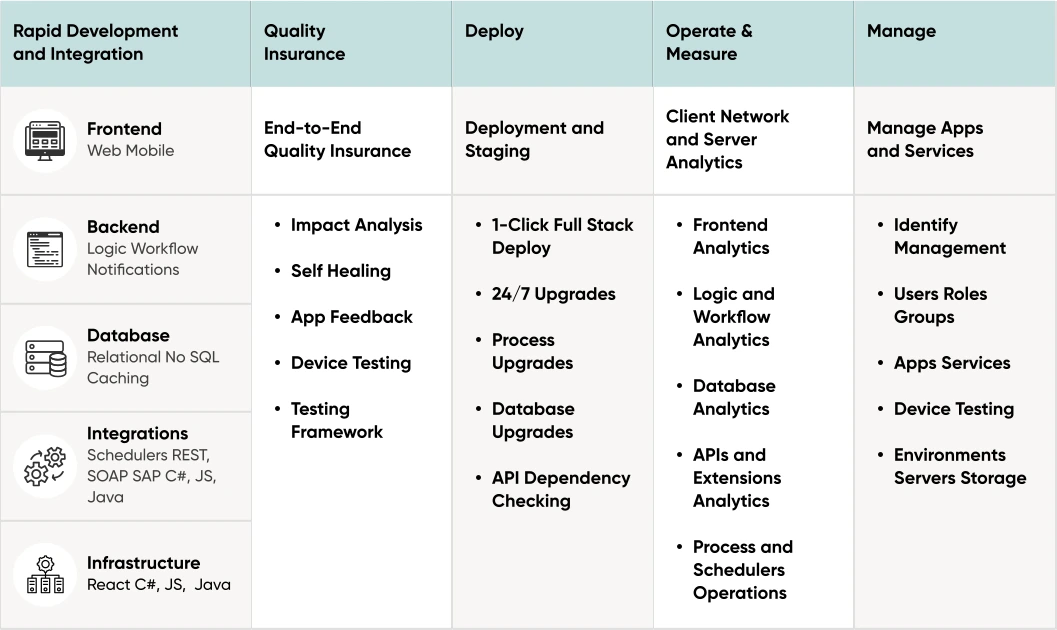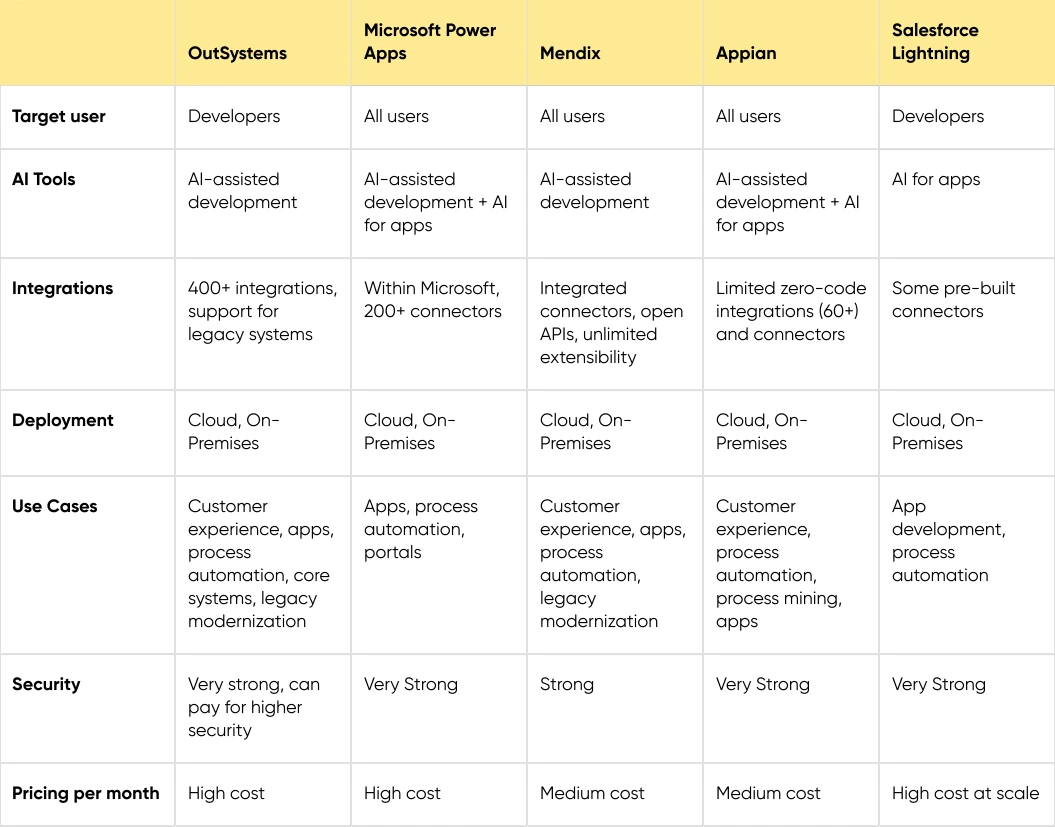Low code development allows businesses to quickly and inexpensively develop applications, accelerating existing IT departments and opening up development to non-technical citizen developers.
In this guide, we will learn about OutSystems, a platform recognized as a Gartner leader for both enterprise low-code development and multiexperience development, helping to boost developer productivity (create 5x more apps!) and support a wide variety of apps that deliver native experiences across various touchpoints.
Before we jump into “What is Outsystems,” let’s first step back into a better understanding of low code development.
Understanding Low-Code Development
Traditionally, software development was isolated to the skills and knowledge of an IT workforce – something now being termed “high code.” However, innovative low code no code platforms are knocking down these knowledge barriers, utilizing a visually-based approach to app design and development, with little to no coding knowledge required.
What does a low-code platform do? Low code no code development uses abstraction in the form of easy templates and drag-and-drop components to create apps, ideally suited for both simple and complex apps and systems, and to support process automation and prototyping. When looking to choose between low code and no code, there are several questions to ask:
What is OutSystems?
What is the OutSystems platform? Is OutSystems low-code or no code? OutSystems is a low-code development platform founded in 2001 in Portugal, today recognized as a leader in developing enterprise apps for the cloud, on-premises, and hybrid environments. OutSystems is leveraged by more than 435k community members across 87 countries worldwide.
The OutSystems platform makes it possible to develop and update apps (web and mobile) quickly and easily with visual tools and AI-based automation. Further, OutSystems is opening the door for low-code core system development, enabling organizations to develop customized solutions for ERP, CRM, and more – fully integrated with existing technology and can innovate at a custom pace, avoiding traditional vendor lock-in.
How OutSystems Works?
What does OutSystems do? The OutSystems Integrated Development Environment (IDE) is a single environment to develop your low-code app, with the option to tap into enterprise-level features for development, testing, production, and full DevOps automation.

OutSystems features thousands of pre-built UI templates, connectors, and modules to speed up development time with the option to extend with HTML, JavaScript, and CSS on the frontend and C# on the backend. The database can be modeled visually and connected to a variety of data sources using open-source connectors, an integration wizard to support other integrations, or custom connections. The OutSystems architecture is layered, providing developers control over the full-stack:

Why Use OutSystems?
OutSystems targets the platform specifically to developers, allowing organizations to utilize existing teams and front-end knowledge to become full-stack developers in OutSystems. It can be used to create the following:
- Customer Experience
Create unified digital experiences for omnichannel applications running on any device and any channel including web, mobile, chat, voice, AR/VR. Leverage real-time data and automations to create consistent, personalized user experiences.
- Operational Efficiency
Create custom applications to monitor and manage businesses at a deeper level than just “tasks,” looking at optimizing overall operations, engagement, team productivity, field service operations and supply chain resilience.
- Workplace Innovation
Empower employees with process improvements and tailored solutions to boost employee morale and create a culture of innovation and responsiveness
- Legacy System Modernization
Digital transformation is driving organizations to become more agile and to attract users across new devices and platforms. OutSystems is helping by focusing on great UX, designing web apps that behave like native mobile apps and supporting legacy application modernization via refactoring or rebuilding or simply extending with new UI and touchpoints.
- Custom Core Systems
Build core systems tailored to your business, no lock-in
- Portals
Build internal or external portals
Key Features of OutSystems
What is OutSystems known for? Key features of the low code OutSystems platform include:
- Simplified development with drag-and-drop and AI
Drag and drop visualization, extensive connectors, AI conversational prompts and full-stack suggestions
- Integration & extensibility
Over 400 system and database connections, extensible to traditional code libraries using C#
- Development tools
Low-code access to front-end and back-end development, including APIs, web services, data models, workflows and business rules as well as tools to identify vulnerabilities, analyze dependencies, remove bottlenecks.
- Security and Compliance
Leverages modern governance and security protections (authentication, identity, vulnerability testing, integrations with other security tools) and automatic security updates. At the most custom end of the OutSystems pricing is OutSystems Sentry, offering reinforced security and compliance.
- Team collaboration and version control
Rather than supporting citizen developers, OutSystems leverages cross-team collaboration between IT and business users,
- Deployment options
Can be deployed on-premise or to the cloud (OutSystems Cloud or public cloud) leveraging Kubernetes, Linux containers and modern cloud services (learn more about container-based architecture to support microservices). Leverages automation and AI to speed up deployment.
OutSystems Benefits and OutSystems Limitations
What are the benefits of low-code OutSystems? The OutSystems platform is helping organizations to build complex applications, modernize legacy applications, streamline workflows and create customized core systems in a low-code way. The OutSystems platform and all its components are continually being updated automatically to the latest security standards, with the option to support even the most complex environments in healthcare, finance and government.
What are the disadvantages of OutSystems? While OutSystems is recognized as an enterprise leader, it is a tool that is designed for a technical audience, rather than a citizen developer, so its use case is less on innovating from any user and more on accelerating developer productivity. Further, OutSystems cost and the learning curve are huge barriers to the use of OutSystems – in fact, OutSystems offers a two-week training course for developers, highlighting that the learning curve is steep.
Comparing OutSystems with Alternatives
OutSystems is more technical than some other low-code development tools such as Microsoft Power Apps and no-code tools such as Bubble, aiming more specifically at simplifying full-stack development or accelerating app development – often billed as a “high-performance low-code platform”. Further, OutSystems’ focus on process automation and core system development are specifically more focused on IT teams.
To answer common comparisons such as OutSystems vs PowerApps or Appian vs OutSystems or Mendix vs Outsystems or even which is better, OutSystems or Salesforce?, we present the following table of the top enterprise-grade low-code development tools:

If you are considering Bubble vs OutSystems, the easiest explanation is to know that Bubble is a no-code tool, far less flexible for full-stack development than OutSystems.
Future Trends and Advancements in OutSystems
While other platforms continue to focus on democratizing tech and development to any user, OutSystems is deepening its niche as the low-code development environment for seasoned developers, offering more tools to design, develop, deploy and manage apps and systems of any complexity and to address modern needs (e.g. compliance, legacy application modernization) and even to become a low-code platform of choice for government agencies (FedRAMP)
How Net Solutions Can Support Your OutSystems Low Code Development
OutSystems is designed to deliver high-performance solutions faster, with less code – but not with no code. To supercharge your development, you require knowledge of coding and UX best practices, which you can get from working with a partner who provides extensive low-code application development services to help you get the most from OutSystems and to support integration into your environment.
FAQs
1.What can I build with OutSystems?
OutSystems can be used to build internal business apps, core systems (e.g. ERP, CRM, logistics), customer apps and portals (internal or external).
No-code platforms offer an easy-to-use visual environment (drag-and-drop) of pre-built components and templates to help make applications. Low-code platforms allow for some coding, in addition to the above tools, to simplify software development.
2.Is OutSystems a cloud platform?
Outsystems is both software-as-a-service (SaaS) and platform-as-a-service (PaaS), with full deployment to the OutSystems cloud.
3.Is OutSystems free or paid? Why is OutSystems so expensive?
Outsystems has a free version that allows the development of a single low-code app for up to 100 end users, but from that point forward the cost jumps quickly to start at $1,513+ per month, but with enterprise-level control over servers, separate runtime environments for development, testing and production, DevOps automation and professional service bundles. Further, OutSystems offers paid upgrades to guarantee higher uptime rates and compliance options. The system is expensive due to the enterprise-oriented features for development.

